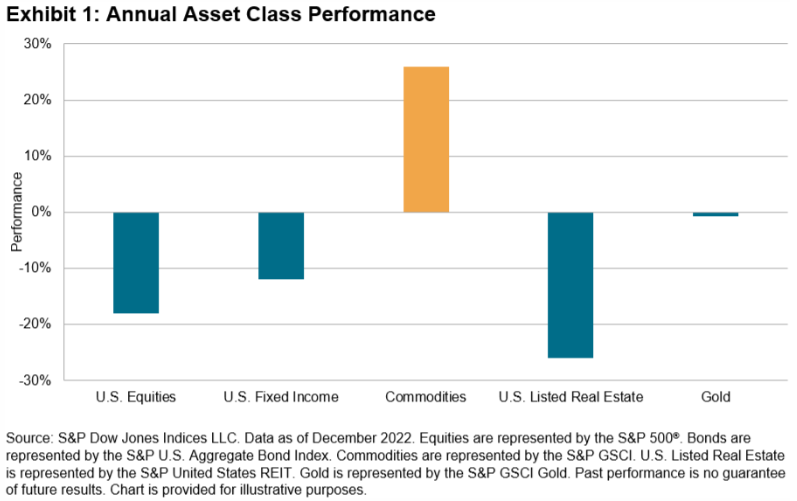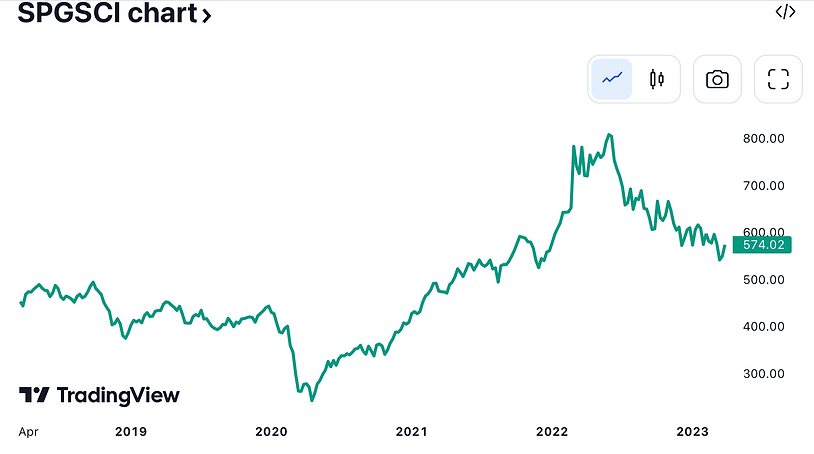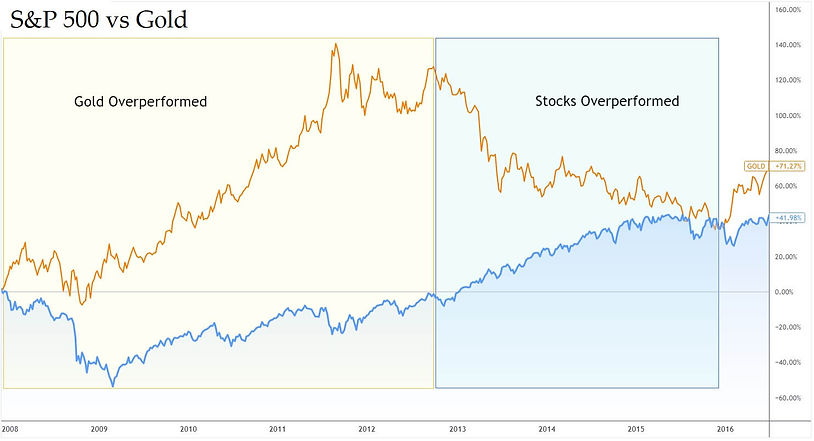Golden Opportunities: Unlocking The Power Of Commodities
From Gold and silver to oil and gas, commodities play a vital role in modern society, powering industries and fueling economic growth.

Photo by Nathan Dumlao on Unsplash
In 2022, the market standard commodities benchmark, the S&P GSCI, rose by 26%, easily outpacing all other asset classes. This marked the second year that commodities outperformed stocks and bonds, demonstrating their resilience in a market fraught with high inflation, macroeconomic uncertainty, geopolitical tensions, and a hawkish Federal Reserve poised to raise interest rates.

Despite these challenges, commodities are anticipated to continue their hot streak, with projections suggesting they will outpace stocks and bonds for a third consecutive year.
So, what makes commodities such an appealing asset class now, and how can you take advantage of this trend?
In this article, we will explore the current state of the commodities market, delve into the concept of commodity super cycles, and discuss how to spot one. We will also highlight the importance of not overlooking commodities as a viable investment option in today's economic climate.
Especially if you are new to the world of investing, this post will provide valuable insights into the world of commodity investing and help you make informed decisions about your investment strategy.
What are Commodities?
Commodities are raw materials essential for producing everyday goods, and they can be categorized into three main groups: agricultural, energy, and metals.
Agricultural commodities
Agricultural commodities are raw materials produced by farming or animal husbandry and traded in large quantities. These commodities include grains such as wheat, corn, rice, and oats and oilseeds like soybeans, cotton, sugar, coffee, cocoa, and livestock products such as beef, pork, poultry, and dairy.
Agricultural commodities are essential to the global economy, as they are used as food for people and animals and raw materials for various industries. However, weather patterns, supply and demand, government policies, and global trade influence their prices.
Energy Commodities
Energy commodities are raw materials used to produce energy, such as crude oil, natural gas, coal, and uranium. These commodities are traded globally and are essential for economic development, transportation, and manufacturing.
Crude oil is the most commonly traded energy commodity, and it is used to produce gasoline, diesel fuel, jet fuel, heating oil, and other products. Natural gas is another vital energy commodity used for heating and electricity generation. In addition, coal is used for electricity generation and steel production, while uranium is used for nuclear power generation.
Metals Commodities
Metal commodities are raw materials used in manufacturing and construction, such as precious metals like gold, silver, platinum, and palladium, and industrial metals such as copper, aluminum, zinc, lead, nickel, and iron ore.
Precious metals have traditionally been used as a store of value and a form of currency, but they are also used in jewelry, electronics, and industrial applications. On the other hand, industrial metals are used extensively in construction, transportation, and manufacturing. For example, copper is used in electrical wiring and plumbing, while aluminum is used in the aerospace, automotive, and construction industries.
These three categories form the foundation of the global commodities market, offering diverse investment opportunities.
How to Invest in Commodities
Commodity trading has a rich history dating back centuries, with formal exchanges established in Amsterdam and Osaka in the 16th and 17th centuries. Today, investors have several ways to trade commodities, including buying the commodity directly, investing in commodity futures contracts, buying shares of commodity ETFs, or purchasing stock in companies that produce commodities, like investing in gold mining companies.
Investing in commodities directly can be daunting, requiring the physical acquisition and storage of the commodity and the need to find a buyer and handle delivery logistics. As such, this approach is often best suited for experienced investors with significant financial resources. However, this approach may sometimes be practical, like silver or Gold investing.

For individual investors, commodity stocks may offer a more accessible option. These stocks provide exposure to companies that produce commodities, such as energy or agriculture companies. However, the value of these stocks may not necessarily reflect the price of the commodity they produce. Instead, investors should consider the company's production levels over time, which can significantly impact the stock's price.
Another approach to investing in commodities is through futures contracts. These contracts require the investor to buy or sell a certain amount of a given commodity at a specific time in the future at a given price. While futures contracts offer direct exposure to changes in commodity prices, they require a significant financial commitment and are typically best suited for institutional investors.
For individual investors, commodity ETFs offer a more accessible and diversified option. ETFs provide exposure to a particular commodity without physically owning it. Some ETFs buy physical commodities, while others use futures contracts. However, investors should be aware of storage costs and other price factors.
What are commodity supercycles, and how can you spot one?
Commodities are cyclical assets, with their performance closely tied to economic health. As a result, they excel during expansions and underperform during slowdowns and recessions. A commodity super cycle is a sustained period, typically lasting over five years, where commodity prices remain above their long-term averages.
Historically, four commodity supercycles have been driven by major structural shifts in the global economy. The first occurred during the US industrial revolution, followed by the post-WWII rebuilding of Europe and Japan, then the surge in energy prices in the 70s and 80s, and finally, China's rapid industrialization from 2000 to 2014.
To spot a potential super cycle, investors should look for trends and factors such as increased demand during economic booms, supply manipulation (e.g., OPEC controlling oil prices), and supply shocks caused by natural disasters, plant failures, or pandemics.
For example, the super cycle from 2000 to 2014 saw copper prices increased six-fold, driven by rapid growth in India and China. Supply bottlenecks, under-investment in the 1990s, and rising extraction costs further fuelled the super cycle. Another example is the recent run-up in oil prices.
In April 2020, oil prices hit negative levels due to heightened fears of the pandemic but saw a spectacular run-up over the next two years due to supply shortages coupled with a strong reopening, which saw prices hit $120/barrel.
Indicators of a late-stage cycle include commodity-themed IPOs, increased M&A activity, and an influx of investment from banks, hedge funds, and institutions. Identifying these signs can help investors spot the next commodity supercycle and adjust their positions accordingly. However, caution is warranted, as the down cycle can be prolonged and the recovery phase painful for those caught unprepared.
Why Investors Shouldn't Overlook Commodities
In the current economic climate, with fragile financial markets and stretched stock and bond valuations, investors need to take a closer look at the diversification of their portfolios. However, due to several influential factors, commodities stand out as strong candidates to outperform other asset classes.
One of the key benefits of investing in commodities is their low to negative correlation with other asset classes, such as US equities. This unique characteristic allows commodities to act as a hedge against unexpected inflation. In addition, by adding commodities to a less volatile portfolio, investors can decrease the overall risk due to this negative correlation.

Experts predict investors will return to the commodity sector, driven by a severe lack of long-term capital expenditure (CapEx). As a result, Goldman Sachs has projected significant returns on commodities over three, six, and twelve-month periods. In addition, further strengthening the demand outlook for commodities, COVID-19 restrictions are easing in China, and there are expectations of smaller rate hikes from the US Federal Reserve.
Commodities such as lithium and rare earth metals also have long-term structural tailwinds working in their favor, including the global transition from fossil fuels, electrification, and the clean energy revolution. In addition, US programs like the Inflation Reduction Act provide subsidies and support for accelerating renewables and infrastructure development.
Low metal stock levels and underinvestment in CapEx have the potential to put supply pressure on metals and oils. Currently, capital is being directed toward lithium mines and processing. In contrast, new copper mines face permitting constraints and lengthy development timelines and meeting the demands of the energy transition calls for increased CapEx to fund new projects.
The London Metal Exchange's (LME) global warehouse network experienced its lowest end-year inventory this century in 2022. This situation results from two years of steady withdrawals, leaving exchange stocks of metals such as zinc and lead almost depleted.
When investors look at commodities, most primarily look at silver and goGoldnvesting. This includes wondering if investing in gold is safe, especially considering its recent decline due to the rapid interest rate hikes and other macroeconomic headwinds.
While the future of investing in gold is unclear over the long term, things look bright, especially over the short and medium time. This is primarily due to the dollar losing its status as the world's reserve currency due to de-globalization efforts from Russia, China, and the Middle East.
Conclusion on Commodities
In an era marked by high inflation, geopolitical tensions, and market uncertainties, commodities have emerged as a standout asset class, providing investors with an essential diversification tool. Their low negative correlation with traditional assets, such as US equities, helps reduce overall portfolio risk while offering a hedge against unexpected inflation. Moreover, with long-term structural tailwinds, such as the global shift towards clean energy and electrification, commodities are poised to continue their strong performance.

Understanding the cyclical nature of commodities and recognizing the signs of a potential super cycle can help investors strategically position themselves for success. In addition, by identifying opportunities within the commodity sector and incorporating them into a diversified portfolio, investors can navigate the complex market landscape with increased confidence and resilience.
As we look ahead, investors must remain vigilant and adapt their strategies to capitalize on the potential of commodities as a vital component of a well-rounded investment portfolio. By keeping a close eye on the evolving market trends and staying informed about the factors driving commodities, investors can seize opportunities and navigate the challenges that lie ahead.
FAQ about Commodity Investing
Is investing in gold good?
Investing in Gold can be a good option for some investors, but it's essential to understand that it's not without risks.
One of the main advantages of investing in Gold is its historic role as a store of value. Gold has been used as a form of currency and a store of wealth for thousands of years, and it's seen as a safe haven asset during economic uncertainty or geopolitical instability. It can also be a good hedge against inflation, as its price tends to rise when inflation is high.
However, there are also risks associated with investing in Gold. For example, its price can fluctuate based on supply and demand, economic conditions, and geopolitical events.
Gold doesn't produce income or dividends, so it's unsuitable for investors seeking regular income. Also, the cost of storing and insuring physical Gold can be relatively high.
Investing in Gold can be done in different ways, such as buying physical gold bullion, investing in gold exchange-traded funds (ETFs), or investing in gold mining companies. Therefore, it is essential to stand the different options and weigh the potential benefits and risks before investing in Gold. Additionally, investors should consider their individual goals, risk tolerance, and investment horizon before making investment decisions.
What are stocks that invest in Gold?
Gold mining companies: Investors can buy shares of companies that mine Gold, such as Barrick Gold Corporation, Newmont Mining Corporation, and Goldcorp Inc. These companies explore, develop, and produce gold and other precious metals.
Gold ETFs: Investors can also buy shares of exchange-traded funds (ETFs) that are backed by physical Gold, such as the SPDR Gold Shares (GLD) or the iShares Gold Trust (IAU). These ETFs allow investors to gain exposure to Gold without owning physical Gold.

Is it better to invest in Gold or silver?
Gold is generally considered a more stable investment than silver, as its price tends to be less volatile. Gold is also more widely recognized as a store of value and is often used as a safe-haven asset during economic uncertainty or geopolitical instability. On the other hand, silver is often used in industrial applications, such as electronics, solar panels, and batteries, which can make its price more sensitive to economic changes.
Silver can also be a more speculative investment than Gold, as its price can be subject to more significant short-term fluctuations. This can make silver more attractive to investors looking for higher potential returns but also make it riskier.

What are the pros and cons of gold investing?
Pros:
-
Hedge against inflation: Gold is often seen as a hedge against inflation since its value tends to rise when inflation is high.
-
Store of value: Gold has been used for thousands of years and is recognized globally as a currency.
-
Diversification: Gold can diversify a portfolio, reducing the overall risk by spreading investments across different asset classes.
-
Safe-haven asset: Gold is often considered a safe-haven asset during economic or political uncertainty, providing a buffer against market volatility.
Cons:
-
Volatility: Gold prices, like any investment, can be volatile, with significant fluctuations over short periods.
-
No income: Gold does not provide any income, such as interest or dividends, which may not be suitable for investors seeking regular income.
-
Storage and insurance costs: Investing in physical Gold requires storage and insurance, which can add additional charges.
-
Limited growth: While Gold may provide a store of value, it does not generate earnings or cash flow like a company's stock, so it may not have the same potential for growth over the long term.
What is the best advice for commodity investing for beginners?
-
Please do your research: Before investing in any commodity, it's essential to do your research and understand the market. Learn about the different types of commodities, how they are traded, and the factors that can impact their prices.
-
Consider your goals and risk tolerance: Commodity investing can be risky, so it's important to consider your objectives and risk tolerance before making any investments. Determine your investment horizon, the level of risk you are comfortable with, and how much you are willing to invest.
-
Diversify your portfolio: Commodity investing should be considered part of a diversified portfolio, with investments spread across different asset classes, such as stocks, bonds, and real estate.
-
Start small: For beginner investors, it's a good idea to start with small investments and gradually increase your exposure as you become more comfortable with the market.
-
Consider different ways to invest: There are many ways to invest in commodities, including futures contracts, options, ETFs, mutual funds, and individual stocks. Each method has risks and benefits, so it's important to understand them before investing.
-
Be prepared for volatility: Commodity prices can be volatile, with significant fluctuations over short periods. Be prepared for this volatility and avoid making impulsive decisions based on short-term price movements.
-
Please consult a financial advisor: Commodity investing can be complex, so it's a good idea to consult a financial advisor specializing in this area. They can advise and help you make informed investment decisions based on your goals and risk tolerance.
More By This Author:
The 8th Wonder Of The World - Compounded Interest
Mastering Macroeconomic Impact: A Guide To Optimizing Investment Returns
Leverage In 2023: The Art Of Walking The Tightrope Of Risk And Reward
GLD IAU NEM
Disclaimer:The information provided is for general educational and informational purposes only and should not be construed as financial advice. Any investment or financial ...
more




